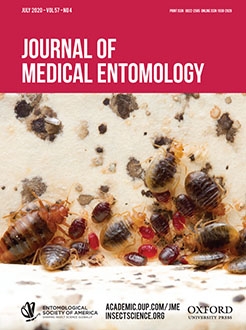Contact irritant (locomotor excitation) and noncontact spatial repellent avoidance behavior to deltamethrin and cypermethrin at dosages 0.025, 0.05, and 0.1 g/m2 impregnated on papers were evaluated in the laboratory against deltamethrin- and cypermethrin-resistant field populations of female Aedes aegypti (L.) from Rayong and Chanthaburi Provinces,Thailand. Pyrethroid-resistant populations were compared with a susceptible laboratory strain (NIH-Thai) using an ‘excito-repellency’ (ER) test system. Both NIH-Thai and field mosquitoes had stronger contact irritancy responses compared to the relatively weak noncontact repellency effects. Contact assays with deltamethrin and cypermethrin at 0.1 g/m2 showed high escape rates for Rayong (80.1 and 83.4%, respectively) and Chanthaburi (84.6 and 73.1%, respectively) mosquitoes. Cypermethrin produced significantly different (P < 0.05) percent escape responses in contact tests between NIH-Thai and field mosquitoes. Only deltamethrin contact at 0.05 g/m2 produced a significant escape response (P < 0.001) between NIH-Thai and Rayong mosquitoes.These results suggest that there may not be an overall significant effect of background pyrethroid resistance on escape response, and the differences by comparisons may reflect inherent individual variation when using the ER bioassay system.The results show that pyrethroid resistance in Ae. aegypti does not appear to influence or reduce contact avoidance responses with the compounds tested. In particular, deltamethrin at 0.1 g/m2 was an effective contact irritant and toxic compound against pyrethroid-resistant populations of Ae. aegypti.Therefore, 0.1 g/m2 deltamethrin could be considered for residual applications of either fixed surfaces or materials (e.g., curtains) as a supplemental control measure against adult dengue vectors.
How to translate text using browser tools
5 February 2020
Behavioral Action of Deltamethrin and Cypermethrin in Pyrethroid-Resistant Aedes aegypti (Diptera: Culicidae): Implications for Control Strategies in Thailand
Sunaiyana Sathantriphop,
Pungasem Paeporn,
Phubeth Ya-Umphan,
Pongsakorn Mukkhun,
Kanutcharee Thanispong,
Chitti Chansang,
Michael J. Bangs,
Theeraphap Chareonviriyaphap,
Krajana Tainchum
ACCESS THE FULL ARTICLE
It is not available for individual sale.
This article is only available to subscribers.
It is not available for individual sale.
It is not available for individual sale.

Journal of Medical Entomology
Vol. 57 • No. 4
July 2020
Vol. 57 • No. 4
July 2020
Aedes aegypti
Behavioral avoidance
cypermethrin
deltamethrin
resistance




